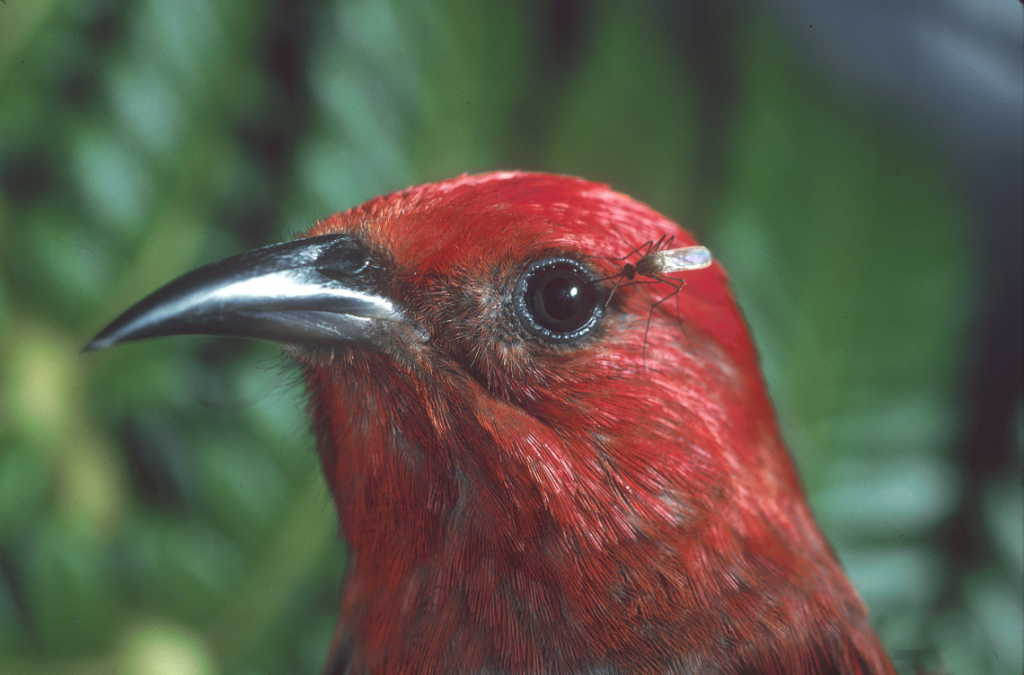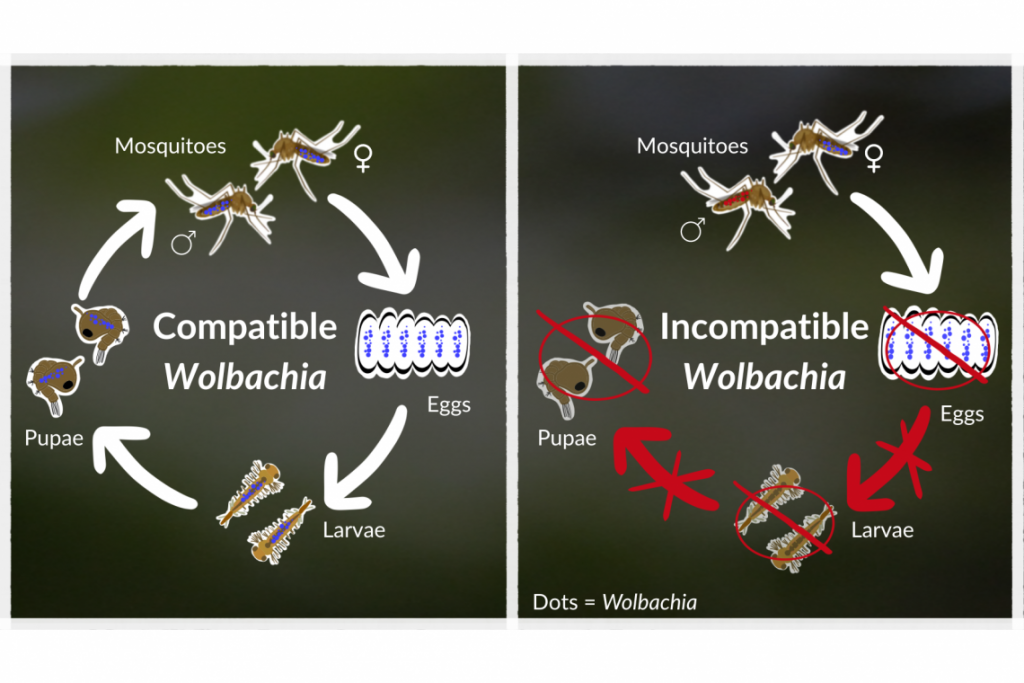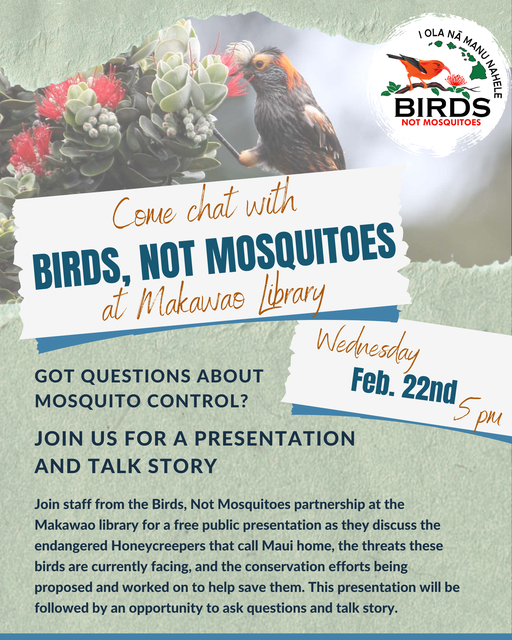The upland realm of wao akua captivates all senses. Freshwater percolates into the earth, perfuming the cool air, and hues of greens and pops of red lehua delight the eyes, but the sound of its most charismatic denizens – the forest birds – is unique in all the world. These jewels of our rainforests – the honeycreepers – once had 54 different species. Today, only 17 remain, and some, like the kiwikiu, have fewer than 200 individual birds. Their plight is mainly due to a sound out of place in a Hawaiian forest – the buzz of a mosquito.

Hawaiian honeycreepers evolved from one common finch ancestor millions of years ago. Some birds, like the ʻiʻiwi, developed long, curved bills to sip nectar out of bell-shaped blossoms, filling their bellies while pollinating the flowers of the forest. Others, like the kiwikiu, developed sturdy beaks to snatch insects from tree bark. The ʻākohekohe, one of the largest honeycreepers, has a feather duster tuft on its forehead and helps spread pollen as it flits from tree to tree. An integral part of native ecosystems, forest birds are important to Hawaiian culture. Kia manu (bird catchers) plucked vermillion and honey-colored feathers for the lei, helmets, and cloaks of Hawaiian royalty. ʻŌlelo noʻeau (Hawaiian proverbs) reference birds in describing love, gossip, industriousness, and beauty. “He kumu lehua muimuia i ka manu,” means an ohia in full bloom attracts forest birds, as an attractive person will bring attention from others.
With the arrival of humans to the Hawaiian archipelago came invasive predators like rats for which native birds had no defense. But the greatest impact on native birds in recent history has been mosquito-borne diseases, primarily avian malaria and avian pox. Out of the 17 honeycreepers that remain, majority are federally endangered or threatened. Kiwikiu and ʻākohekohe populations have decreased by more than 70 percent over the last 20 years. Scientists predict their extinction in two to fifteen years if no action is taken to control mosquitoes in the forest.

Mosquitoes, and the diseases they transmit, don’t thrive in colder environments and have historically been restricted to warmer, lower elevations. Unfortunately, a warming climate is allowing these pests to reach high-elevation forest bird habitat, the last refugia. The southern house mosquito is the primary vector of avian malaria and has a 100% transmission rate. Some birds are particularly at risk – just one bite from an infected mosquito can mean death for a vulnerable forest bird.
The southern house mosquito is the primary vector of avian malaria and has a 100% transmission rate. Some birds are particularly at risk – just one bite from an infected mosquito can mean death for a vulnerable forest bird.
The multi-agency Birds, Not Mosquitoes Project is urgently working to save our native honeycreepers from extinction. They have been exploring use of a naturally-occurring bacteria that is present in over half of all insect species worldwide, including many in Hawaiʻi. This bacteria, called Wolbachia, affects mosquito reproduction. Luka Zavas, Outreach Manager with the American Bird Conservancy, one of the agencies involved in the project, explains how it works. “When male and female mosquitoes have matching Wolbachia strains, the sperm and egg are like connecting puzzle pieces that result in fertile eggs. When a male mosquito has a different, incompatible strain than its female mate, their puzzle pieces won’t match, resulting in infertile eggs.”

Researchers hope to save our honeycreepers by raising and releasing male mosquitoes with an incompatible strain of Wolbachia, Swamping the dating pool with unproductive males effectively puts wild mosquito populations on birth control. Repeated releases over time suppress the overall population of mosquitoes and reduce the transmission of avian malaria, with the goal of giving our Hawaiian honeycreepers a fighting chance for survival.
Those working on the project stress that male mosquitoes don’t bite, Wolbachia doesn’t harm people, animals, or the environment, and the process doesn’t modify any genes. The same technique is used elsewhere in the world to control mosquitoes that transmit human malaria.
On Maui, approximately 64,000 acres of federal, state, and privately-managed lands have been identified as a proposed project area for the release of incompatible male mosquitoes. Environmental Assessments prepared for the state and Haleakalā National Park outline the proposed release strategy as well as plans for monitoring mosquito and bird populations to track progress.
For more information on the project, visit birdsnotmosquitoes.org. Luka Zavas will give a community presentation on February 22, 2023, at 5:00 p.m. at the Makawao Public Library. More information can be found here.

Serena Fukushima is the public relations and education specialist for the Maui Invasive Species Committee. She holds a bachelor’s degree in environmental studies and a graduate degree in education from the University of Hawaii at Manoa. “Kia’i Moku, Guarding the Island” is written by the Maui Invasive Species Committee to provide information on protecting the island from invasive plants and animals that threaten our islands’ environment, economy and quality of life.
This article was originally published in the Maui News on February 11, 2023 as part of the Kia‘i Moku Column from the Maui Invasive Species Committee.
Read more Kiaʻi Moku articles
